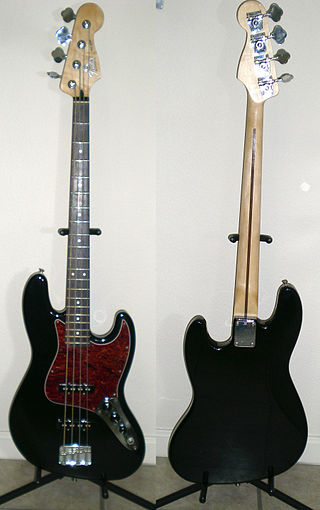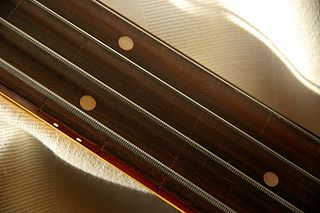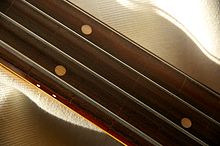
The bass guitar, electric bass or simply bass is the lowest-pitched member of the guitar family. It is a plucked string instrument similar in appearance and construction to an electric or acoustic guitar, but with a longer neck and scale length. The bass guitar most commonly has four strings, though five- and six-stringed models are also relatively popular, and bass guitars with even more strings or courses have been built. Since the mid-1950s, the bass guitar has largely come to replace the double bass in popular music due to its lighter weight, the inclusion of frets in most models, and, most importantly, its design for electric amplification. This is also due to the fact that the double bass is acoustically compromised for its range in that it's scaled down from the optimal size that would be appropriate for those low notes.

The double bass, also known as the upright bass, the acoustic bass, or simply the bass, is the largest and lowest-pitched chordophone in the modern symphony orchestra. Similar in structure to the cello, it has four or five strings.

A bassist is a musician who plays a bass instrument such as a double bass, bass guitar, synthbass, keyboard bass or a low brass instrument such as a tuba or trombone. Different musical genres tend to be associated with one or more of these instruments. Since the 1960s, the electric bass has been the standard bass instrument for funk, R&B, soul music, rock and roll, reggae, jazz fusion, heavy metal, country and pop music. The double bass is the standard bass instrument for classical music, bluegrass, rockabilly, and most genres of jazz. Low brass instruments such as the tuba or sousaphone are the standard bass instrument in Dixieland and New Orleans-style jazz bands.

John Francis "Jaco" Pastorius III was an American jazz bassist, composer, and producer. Widely regarded as one of the greatest and most influential bassists of all time, Pastorius recorded albums as a solo artist, band leader, and as a member of the jazz fusion group Weather Report from 1976 to 1981. He also collaborated with numerous artists, including Pat Metheny and Joni Mitchell.

A fret is any of the thin strips of material, usually metal wire, inserted laterally at specific positions along the neck or fretboard of a stringed instrument. Frets usually extend across the full width of the neck. On some historical instruments and non-European instruments, frets are made of pieces of string tied around the neck.

Zithers are a class of stringed instruments. Historically, it could be any instrument of the psaltery family. In modern terminology, it is more specifically an instrument consisting of many strings stretched across a thin, flat body, the topic of this article.

The acoustic bass guitar is a bass instrument with a hollow wooden body similar to, though usually larger than, a steel-string acoustic guitar. Like the traditional electric bass guitar and the double bass, the acoustic bass guitar commonly has four strings, which are normally tuned E-A-D-G, an octave below the lowest four strings of the 6-string guitar.

Giuseppe Henry "Pino" Palladino is a Welsh musician, songwriter, and record producer. A prolific session bassist, he has played bass for a number of acts such as the Who, the John Mayer Trio, Gary Numan, Paul Young, Don Henley, David Gilmour, Go West, Tears for Fears, Nine Inch Nails, Jeff Beck, Adele and D'Angelo.
The fingerboard is an important component of most stringed instruments. It is a thin, long strip of material, usually wood, that is laminated to the front of the neck of an instrument. The strings run over the fingerboard, between the nut and bridge. To play the instrument, a musician presses strings down to the fingerboard to change the vibrating length, changing the pitch. This is called stopping the strings. Depending on the instrument and the style of music, the musician may pluck, strum or bow one or more strings with the hand that is not fretting the notes. On some instruments, notes can be sounded by the fretting hand alone, such as with hammer ons, an electric guitar technique.

Roberto Agustín Miguel Santiago Samuel Trujillo Veracruz is an American musician who has been the bassist for heavy metal band Metallica since 2003. He first rose to prominence as the bassist of crossover thrash band Suicidal Tendencies from 1989 to 1995, while also collaborating with Suicidal Tendencies frontman Mike Muir for funk metal supergroup Infectious Grooves. After leaving Suicidal Tendencies, he performed with Ozzy Osbourne, Jerry Cantrell, and heavy metal band Black Label Society. Trujillo joined Metallica in 2003 and is the band's longest-serving bassist. He was inducted to the Rock and Roll Hall of Fame as a member of Metallica in 2009.

A fretless guitar is a guitar with a fingerboard without frets, typically a standard instrument that has had the frets removed, though some custom-built and commercial fretless guitars are occasionally made. The classic fretless guitar was first pioneered in 1976 by Turkish musician Erkan Oğur. Fretless bass guitars are readily available, with most major guitar manufacturers producing fretless models.

The Fender Precision Bass is a model of electric bass guitar manufactured by Fender Musical Instruments Corporation. In its standard, post-1957 configuration, the Precision Bass is a solid body, four-stringed instrument usually equipped with a single split-coil humbucking pickup and a one-piece, 20-fret maple neck with rosewood or maple fingerboard.

The Fender Jazz Bass is the second model of electric bass created by Leo Fender. It is distinct from the Precision Bass in that its tone is brighter and richer in the midrange and treble with less emphasis on the fundamental frequency. The body shape is also different from the Precision Bass, in that the Precision Bass has a symmetrical lower bout on the body, designed after the Telecaster and Stratocaster lines of guitars, while the Jazz Bass has an offset lower bout, mimicking the design aesthetic of the Jaguar and Jazzmaster guitars.

Jazz bass is the use of the double bass or electric bass guitar to improvise accompaniment ("comping") basslines and solos in a jazz or jazz fusion style. Players began using the double bass in jazz in the 1890s to supply the low-pitched walking basslines that outlined the chord progressions of the songs. From the 1920s and 1930s Swing and big band era, through 1940s Bebop and 1950s Hard Bop, to the 1960s-era "free jazz" movement, the resonant, woody sound of the double bass anchored everything from small jazz combos to large jazz big bands.

The electric upright bass (EUB) is an instrument that can perform the musical function of a double bass. It requires only a minimal or 'skeleton' body to produce sound because it uses a pickup and electronic amplifier and loudspeaker. Therefore, a large resonating structure is not required to project the sound into the air. This minimal body greatly reduces the bulk and weight of the instrument. EUBs must always be connected to an amplifier and speaker cabinet to produce an adequate audible sound. The EUB retains enough of the features of the double bass so that double bass players are able to perform on it.

A string is the vibrating element of chordophones such as the guitar, harp, piano, and the violin family, that produces sound. Strings are lengths of a flexible material that a musical instrument holds under tension so that they can vibrate freely, but with control. This is to make the string vibrate at the desired pitch, while maintaining a low profile and sufficient flexibility to play in action.
An extended-range bass is an electric bass guitar with a wider frequency range than a standard-tuned four-string bass guitar.
A solid-body musical instrument is a string instrument such as a guitar, bass or violin built without its normal sound box and relying on an electromagnetic pickup system to directly detect the vibrations of the strings; these instruments are usually plugged into an instrument amplifier and loudspeaker to be heard. Solid-body instruments are preferred in situations where acoustic feedback may otherwise be a problem and are inherently both less expensive to build and more rugged than acoustic electric instruments.

Each bass guitar tuning assigns pitches to the strings of an electric bass. Because pitches are associated with notes, bass-guitar tunings assign open notes to open strings. There are several techniques for accurately tuning the strings of an electric bass. Bass method or lesson books introduce one or more tuning techniques, such as:

Heavy metal bass is the use of the bass guitar in the rock music genres of heavy metal and hard rock. The bassist is part of the rhythm section in a heavy metal band, along with the drummer, rhythm guitarist and, in some bands, a keyboard player. The prominent role of the bass is key to the metal sound, and the interplay of bass and distorted electric guitar is a central element of metal. The bass guitar provides the low-end sound crucial to making the music "heavy". The bass plays a crucial role in heavy metal and a more important role than in traditional rock."


















